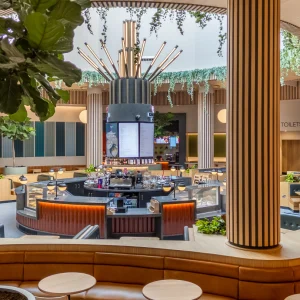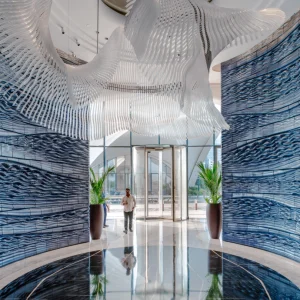ONE OF THE fundamental virtues of the Daylight Award is that it acknowledges the crucial relationship between architecture, human beings and natural light. Not only are there two categories, one for architecture and one for research, but the research award generally honours work that has joined the dots in some way between human beings and their environment. ‘The award acknowledges and encourages scientific knowledge and practical applications of daylight that interlink varying disciplines,’ says the mission statement.
 In Time? is a giant clock for the German city of Mannheim, designed by Mumbai-based Studio Aditya Mandlik
In Time? is a giant clock for the German city of Mannheim, designed by Mumbai-based Studio Aditya Mandlik
All life on Earth evolved under the cycle of night and day, and as well as affecting all nature, this rhythm has a profound effect on the human biological system – sleep especially – and psyche. Given that a large number of people spend a significant part of their lives at work, we are becoming increasingly aware of the massive implications for the design and lighting of the working environment and other spaces where human spend extensive periods of time, from hospitals to educational institutions.
LEADING LIGHTS
The Daylight Award recognises important work in two categories: Daylight Research and Daylight in Architecture. We report on this year’s prize winners
This year’s winner of the Daylight Research award is a pioneer in the field: Till Roenneberg, emeritus professor of chronobiology at the Institute of Medical Psychology at Ludwig-Maximilian University (LMU) in Munich. Roenneberg has dedicated most of his career to investigating the effects of light on circadian clocks, sleep and health, coining the term ‘social jetlag’ along the way. The recipient of numerous international awards and honorifics, he founded Chronsulting in 2015 with the aim of translating his experience of almost 50 years of clock and sleep research to the real world.
He began working on biological rhythms with German physician, biologist and behavioural physiologist Jürgen Aschoff, considered to be a co-founder of the field of chronobiology, at the age of 17. After studying biology in Munich (LMU) and London (UCL), he worked at Harvard.
His work spans the natural and social sciences, and his research and publications have promoted understanding of the many aspects and impacts of daylight, and lighting in general, for human health, well-being and performance. His findings have been influential, said the jury, and applied to a number of fields including medicine, public policy and architecture.
Roenneberg pioneered the epidemiology of chronotypes (the relationship between the circadian clock and the natural daylight-dark cycle: the now familiar larks and owls). He showed, for example, that the relative timing of human entrainment (‘chronotype’) changes with age (which, for instance, puts the late-hour preferences of teenagers in a biological perspective) and with day length. This was applied practically when he worked with the steel industry to evaluate and allocate workers to their chronotype-specific shift. This change resulted in significantly improved sleep for most individuals.
All organisms, from primitive bacteria to human beings, have a biologically determined, internal body clock and it is his work with these diverse groups of organisms – including algae and fungi – that has characterised his interdisciplinary approach, said jurors, allowing him ‘to take novel approaches to address key questions relating to the effects of daylight on human health, well-being and performance’.
‘He was one of the first chronobiologists to appreciate that both the intensity and the spectral composition of light was key in understanding how light affects the circadian system in a range of organisms,’ they continued.
After establishing key concepts related to light and circadian rhythms, Roenneberg moved to human and social sciences, with a focus on daylight. He used his experience in lab-based chronobiology and big data to address research questions that focused on human daily behaviour in real life.
In 1976, he developed a new questionnaire – the Munich ChronoType Questionnaire (MCTQ) – to enable investigations of circadian entrainment in populations across the world. The resulting database has more than 400,000 entries and has allowed him to investigate important questions in ‘real-life experiments’.
A key observation by Roenneberg, said the jury, is the demonstration that human clocks remain profoundly influenced by the natural light/dark cycle, despite increasing urbanisation. His ‘social jetlag’ concept, the difference in sleep timing between work and free days, reflects changes individuals must make for work patterns that are counter to their natural biology.
While social jetlag is an apparently innocuous term, when it is prolonged it becomes a biological challenge to an individual’s circadian and sleep systems, discovered Roenneberg, who went on to link it with obesity, depression and substance abuse.
He has continued to demonstrate the importance of daylight on human circadian rhythms and sleep in longitudinal studies of humans living in different environments. He has shown that circadian clocks resist the artificial social clock changes associated with Daylight Saving Time (DST) as compared with Standard Time (ST) when social clocks and daylight are more aligned. In his recent work, he has studied how industrialisation (with its associated changes in exposure to daylight versus artificial light) influences circadian rhythms and sleep. This has involved studying communities in Brazil, such as the Quilombolas, whose lifestyles range from rural (and without electricity) to modern urban.
The jury was ‘deeply impressed’ by Roenneberg’s fundamental research findings, their application to help resolve real-world issues and his ability to communicate this work to both scientific and public audiences. ‘He is an exemplary scientist,’ said the judges. ‘With energy and enthusiasm, he applies innovative approaches to understand the importance of natural light on human health.’
SOCIAL JETLAG
‘Our lives are governed by three clocks: the social clock that organises our lives with others (local time), the biological clock that controls our physiology (circadian time) and the sun clock that defines natural light and darkness. The more misaligned these clocks are, the higher our odds of developing certain diseases. “Social jetlag” quantifies the difference between local and circadian time.’
Till Roenneberg
‘In the old days, before we had industrialisation and before we had electrical light, or artificial light, we had practically no light during the night, after sunset, and we had an enormous amount of light when we went outside, which most of us did in that era because we were agriculturally or otherwise occupied. If we go outside on a rainy day, we get about 10,000 lux or more. Lux is just a dimension that we use to measure light intensity. On a clear sky day, we get over a hundred thousand lux. If we stay inside, which we have done for the past 100 years, because we are working, either in factories or in offices, we can be lucky if we get 400 lux. So it’s a fraction of the light that we used to get during the day.
But we are not so lucky to still get something like 100 to 200 lux after sunset because we’re switching on lights when our clocks used to have darkness. The clocks are set by light and darkness, and if you have very strong light during the day and no light during the night, this is what we call a very strong time giver to signal for the clock to set itself.
We have weakened that time giver enormously by not going outside during the day, and by switching on light during the night. For most of us that meant that our clocks had to become later, in order to still synchronise to the 24-hour day. And that is always forgotten. Although we all know it without thinking about it.
Our clocks are so late that over 80% of the population need an alarm clock to wake up in the morning. Now if you need an alarm clock to wake up in the morning, your biology hasn’t slept to the end. Because your clock is late and you have to wake yourself up in order to go to work, or to school.
The important thing is that this is really light dependent. Our internal clocks cannot be set by the alarm that goes off on the mobile phone, or any other alarm. It’s light and darkness that set our clocks.’
 The Daylight Award was established by the philanthropic foundations Villum Foundation, Velux Foundation and Velux Stiftung ‘to honour and support daylight research and daylight in architecture’. The award is conferred biennially in two categories: Daylight Research and Daylight in Architecture. www.thedaylightaward.com. Image Credit: Mike Pellinni/ www.Shutterstock.Com
The Daylight Award was established by the philanthropic foundations Villum Foundation, Velux Foundation and Velux Stiftung ‘to honour and support daylight research and daylight in architecture’. The award is conferred biennially in two categories: Daylight Research and Daylight in Architecture. www.thedaylightaward.com. Image Credit: Mike Pellinni/ www.Shutterstock.Com
Till Roenneberg, edited extract from www.project-sleep.com interview
‘We really have to change both the physics of our illumination and the architecture of our houses. Basically, we have to be able to go camping every day, even in the office. Meaning we have to get the lighting that we encounter when we go camping, into the offices and building. We have to simulate what’s going on outside.
 Internal Time: Chronotypes, Social Jet Lag, and Why You’re So Tired Author: Till Roenneberg Publisher: Harvard University Press (2012) Website: www.hup.harvard.edu/books/9780674975392. Image Credit: The Daylight Award
Internal Time: Chronotypes, Social Jet Lag, and Why You’re So Tired Author: Till Roenneberg Publisher: Harvard University Press (2012) Website: www.hup.harvard.edu/books/9780674975392. Image Credit: The Daylight Award
It’s the architects and the light specialists who have to do that. We have to get the light that arrives at the roof of buildings. We have to get that into the ceilings of offices, so it’s really bright – and diffuse, like the light in the sky. But we also have to tune all illuminations spectrally, so that after sunset – and that’s local sunset, in Chicago or in Georgia or in Munich – to practically take away the blue content of any artificial light. So that we just have enough spectral variability in the light that we can see properly. But otherwise take away every blue.

My goal is that none of us will need an alarm clock in the future and we can do that by either having very flexible work times, or – going camping all the time, light wise.‘
Till Roenneberg, edited extract from www.project-sleep.com interview
DAYLIGHT IN ARCHITECTURE AWARD
 Alberto Campo Baeza’s ‘buildings exemplify the spiritual qualities of daylight and thus expand the understanding of the values of daylight beyond the current scope of science’
Alberto Campo Baeza’s ‘buildings exemplify the spiritual qualities of daylight and thus expand the understanding of the values of daylight beyond the current scope of science’
The 2024 biennial Daylight in Architecture was given to Spanish architect Alberto Campo Baeza. His work, said the jury, is ‘a celebration of the silent miracles of daylight in buildings of widely differing functions. His buildings exemplify the spiritual qualities of daylight and thus expand the understanding of the values of daylight beyond the current scope of science.’
Campo Baeza is an internationally recognised and widely published minimalist architect, who also served as a professor at the Escuela Technica Superior de Arquitectura de Madrid from 1986-2017.
 Alberto Campo Baeza’s ‘buildings exemplify the spiritual qualities of daylight and thus expand the understanding of the values of daylight beyond the current scope of science’
Alberto Campo Baeza’s ‘buildings exemplify the spiritual qualities of daylight and thus expand the understanding of the values of daylight beyond the current scope of science’
His buildings – invariably brilliantly white, both inside and outside – continue the vernacular of white-washed houses around the Mediterranean. Based on a simple, regular, rectangular and repetitious structure they ‘heighten the presence and healing power of natural light,’ said the jury.
They may appear as a single white rectangle in the landscape (Casa Guerrera), or, by the ocean, a mysterious white horizontal roof plane with carefully positioned apertures (House of the Infinite). ‘Even windows appear as mere rectangular openings or narrow horizontal slits cut into the walls, instead of being presented as technical devices,’ commented the judges.
‘Campo Baeza has numerous brilliant examples of architectural light as directed and focused beams of light creating a sense of focus, drama and significance,’ concluded the jury.
 Alberto Campo Baeza’s ‘buildings exemplify the spiritual qualities of daylight and thus expand the understanding of the values of daylight beyond the current scope of science’. Image Credit: The Daylight Award
Alberto Campo Baeza’s ‘buildings exemplify the spiritual qualities of daylight and thus expand the understanding of the values of daylight beyond the current scope of science’. Image Credit: The Daylight Award
‘But the uniqueness of his architecture is to make us aware of the presence of daylight around us.’
TIME OUT IN MANNHEIM
A proposed giant clock installation in the German city will generate energy for the grid and its own light sources, and provide a shaded gathering space
FOLLOWING ON from the Arch in Time in Houston (See FX Jan/Feb 24), another public art proposal pointing to a sustainable future will be realised this year by the Land Art Generator Initiative (LAGI), this time in Mannheim, southwest Germany.
LAGI is a non-profit organisation dedicated to advancing climate solutions through art and design. Its vision of the transition to renewable energy ‘is one in which artists and designers play a key role in bringing green technologies into landscapes and cities’, it says, ‘using solar modules and other clean tech as media for creative expression and placemaking’.
Since 2008 it has been holding open call international design competitions for cities around the world and has amassed a portfolio of thousands of ideas ‘to demonstrate how renewable energy can be beautiful’.
In Time? is a giant clock for the German city, designed by Mumbai-based Studio Aditya Mandlik, and with a built area of 7,850m2. As well as being powered by solar energy, and generating 1,077.6MWh of energy annually, its other benefits are food production, water harvesting and providing a shaded gathering space.
Located at a cross junction of streets and an existing railway route, its circular form is a foil to the linear urban landscape. The clock is sliced into seven pie segments, representing the seven days of the week, divided by pathways accessible to the public. Each of these segments has 24 columns to represent the number of hours in a day. As time passes, the hour column glows, suggesting a countdown to addressing the current climate urgency.
The column also acts as a ‘metabolic element’. From top to bottom, it comprises light cones, parametric solar fins, horticulture pods, vertical gardens and energy reservoirs.
The greenery growing around and up the columns, together with the shading from the solar fins that branch off the columns below the light sources, makes the installation a conducive social space. Diff erent elements in each of the segments are designed to encourage diff erent responses from people.
The design and positioning of the installation responds to both local parameters and existing street compositions, as well as incident radiation, which is calculated to capitalise on the position of the sun during the summer months, starting from April to October.
The geometry of the clock segments is further optimised to maximise their radiation exposure. While 24 of the hour columns are organised in the same pattern for each segment, the modulations and resulting variations of the algorithmically optimised geometry are reflected in their diff erent heights. The solar fins, which will automatically adjust to maximise sun exposure, are made of multi-junction solar cells that have a higher conversion eff iciency than that of traditional photovoltaics.
 One of the clock’s seven segments, which represent the seven days of the week
One of the clock’s seven segments, which represent the seven days of the week
The conversion eff iciency arrived at by Mandlik is assumed to be 42.5% (theoretically 87%) ‘to reflect a real-life scenario’. The ground area houses energy reservoirs and their connections with the city grid. The estimated energy that the installation will generate (1,077.6MWh) is therefore based on calculating 42.5% of the annual incident radiation. Each segment of the pie will actually vary slightly in the energy it generates (between 11.5% and 16.4%).
 The installation is aligned with key United Nations Sustainable Development Goals
The installation is aligned with key United Nations Sustainable Development Goals
Around 67% of the total energy produced is directed towards the city grid, supporting approximately 200 households based on the average household consumption of 3,500kWH, and the remaining 43% is used by the proposal itself.
However, partially filtered wastewater is drawn from the city grid for the maintenance of the vertical gardens and to aid the process of plantation growth from seed to the sapling stage, housed within the horticulture pods. Of the 43% of self-used energy, 28% is used for vertical farming processes, 11% for the rotatory motion of the solar fins on activation, and just 4% for the light cones.
 The segments will be divided by pathways that are accessible to the public
The segments will be divided by pathways that are accessible to the public
The installation is aligned with key UN Sustainable Development Goals, including ensuring well-being, promoting access to sustainable energy, and combating climate change. www.adityamandlik.com | www.landartgenerator.org
MULTI-JUNCTION SOLAR CELLS

The solar fins are made of multi-junction solar cells These are cells with multiple p–n junctions made of different semiconductor materials. In response to different wavelengths of light, the p–n junction of each material will produce electrical current. The use of many semiconducting materials allows for the absorption of a wider range of wavelengths, enhancing the cell’s absorption of sunlight to convert to electrical energy. www.sciencedirect.com





